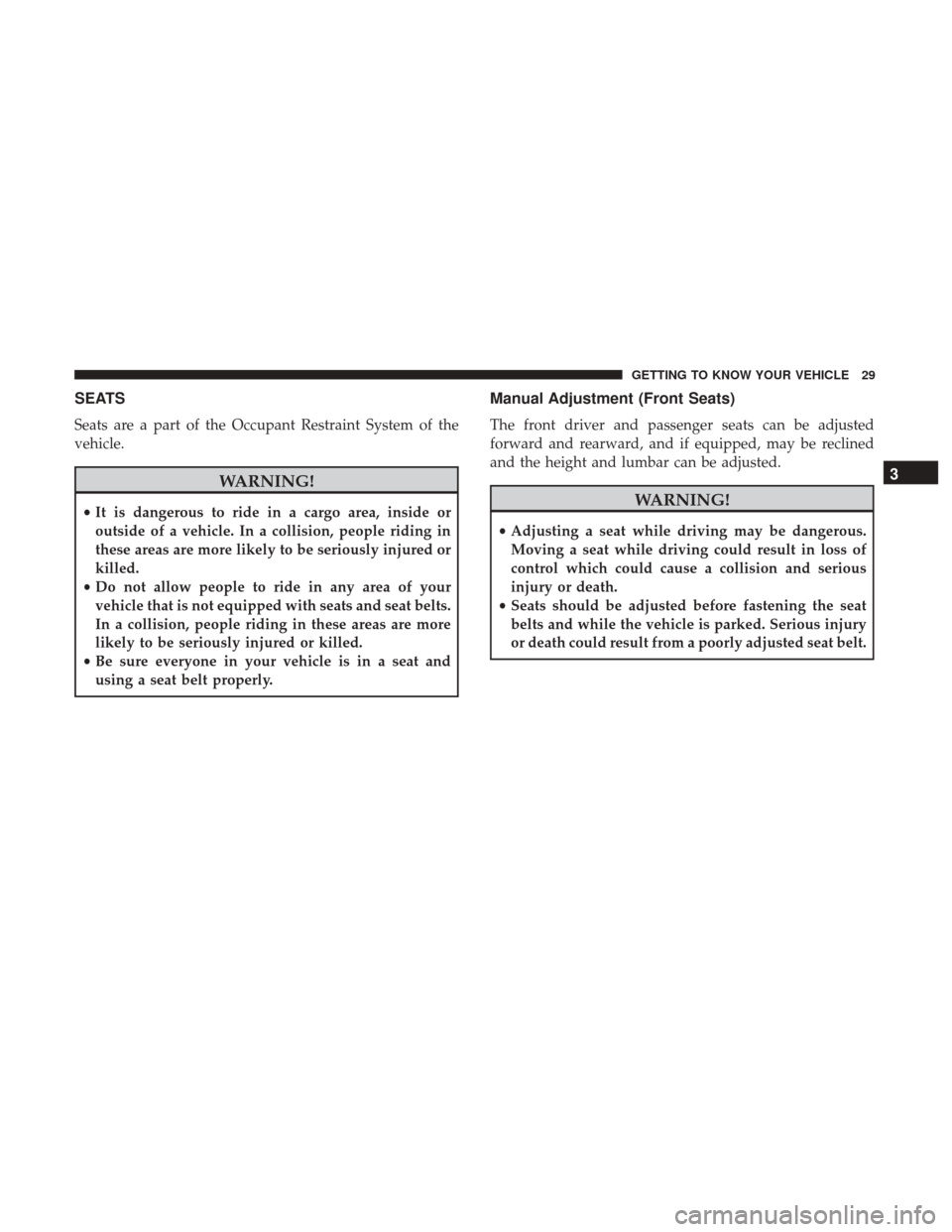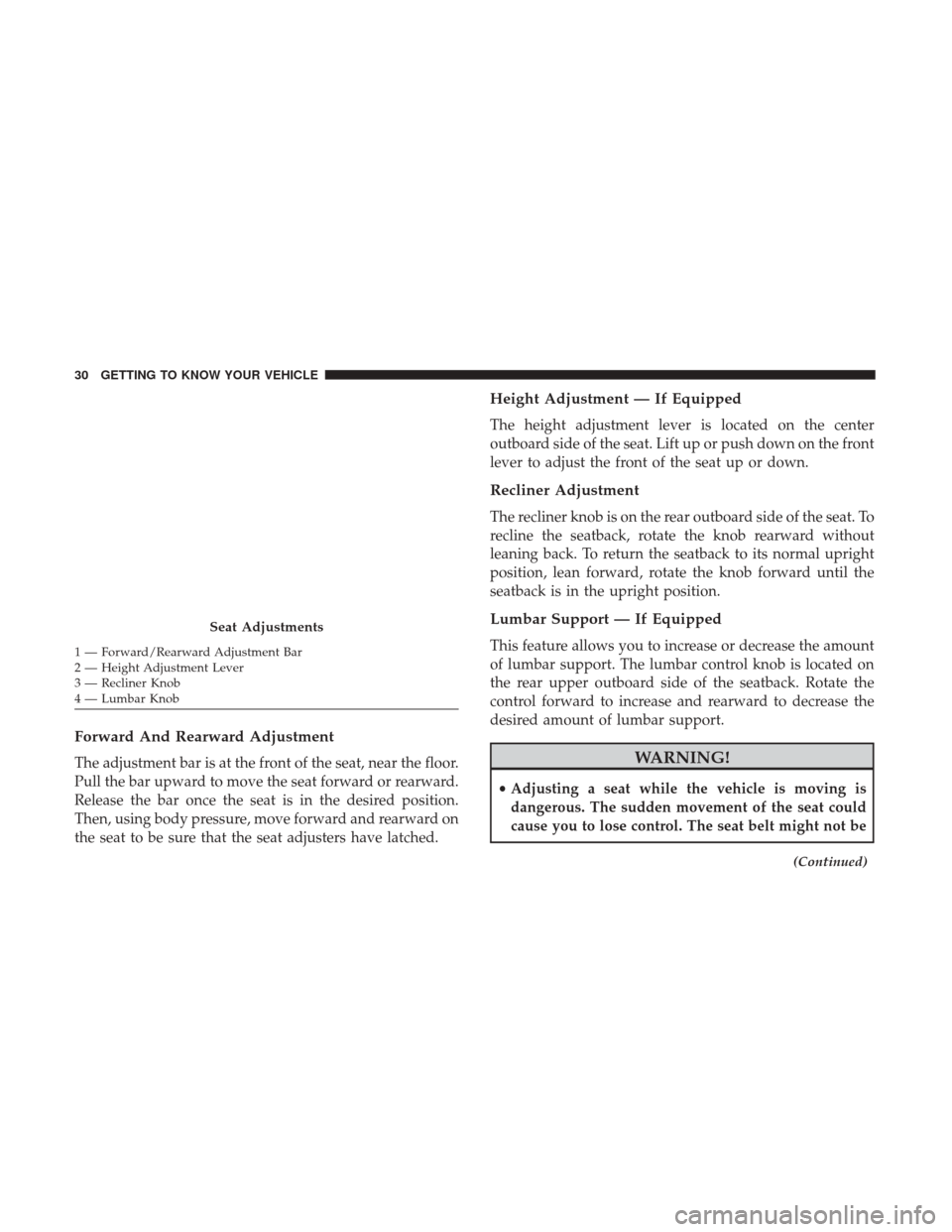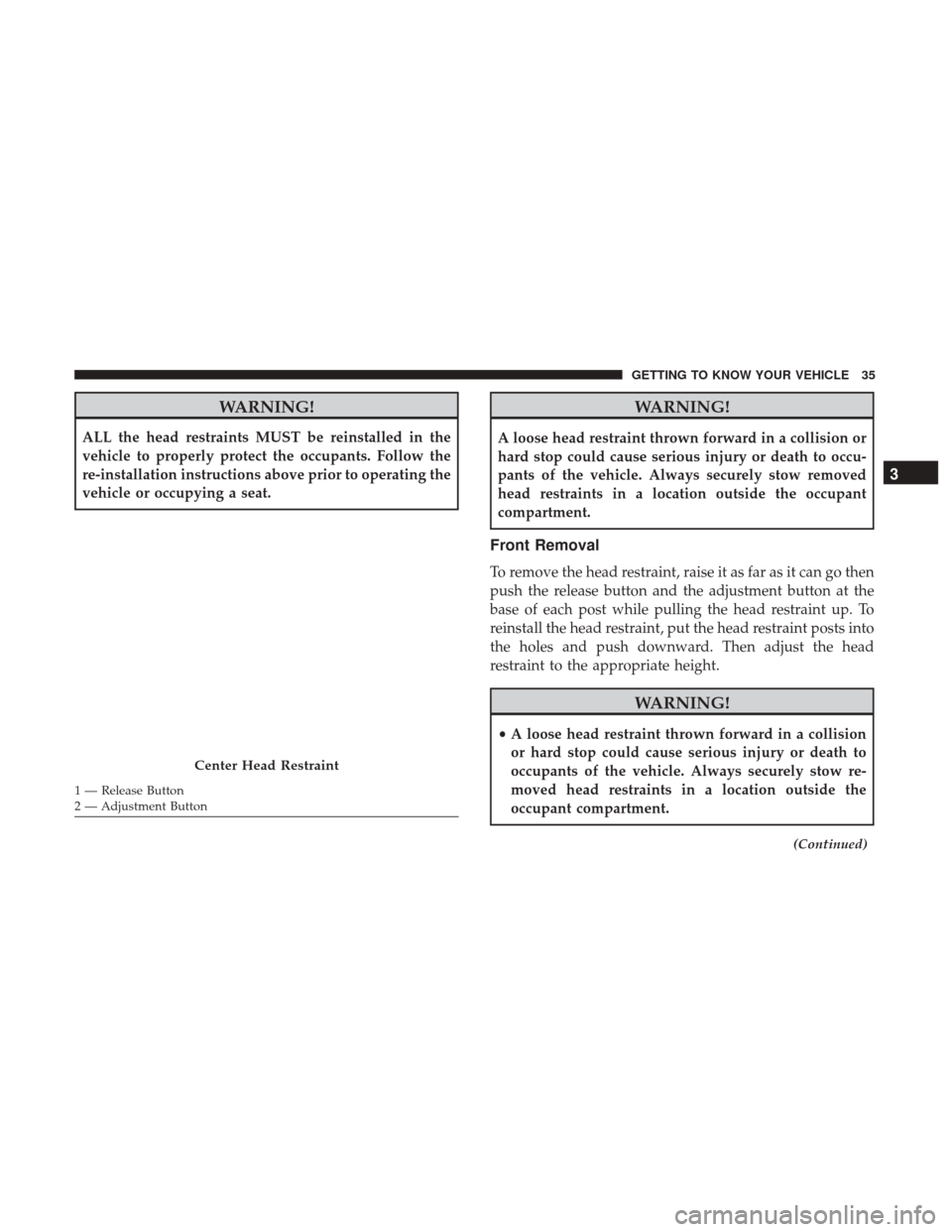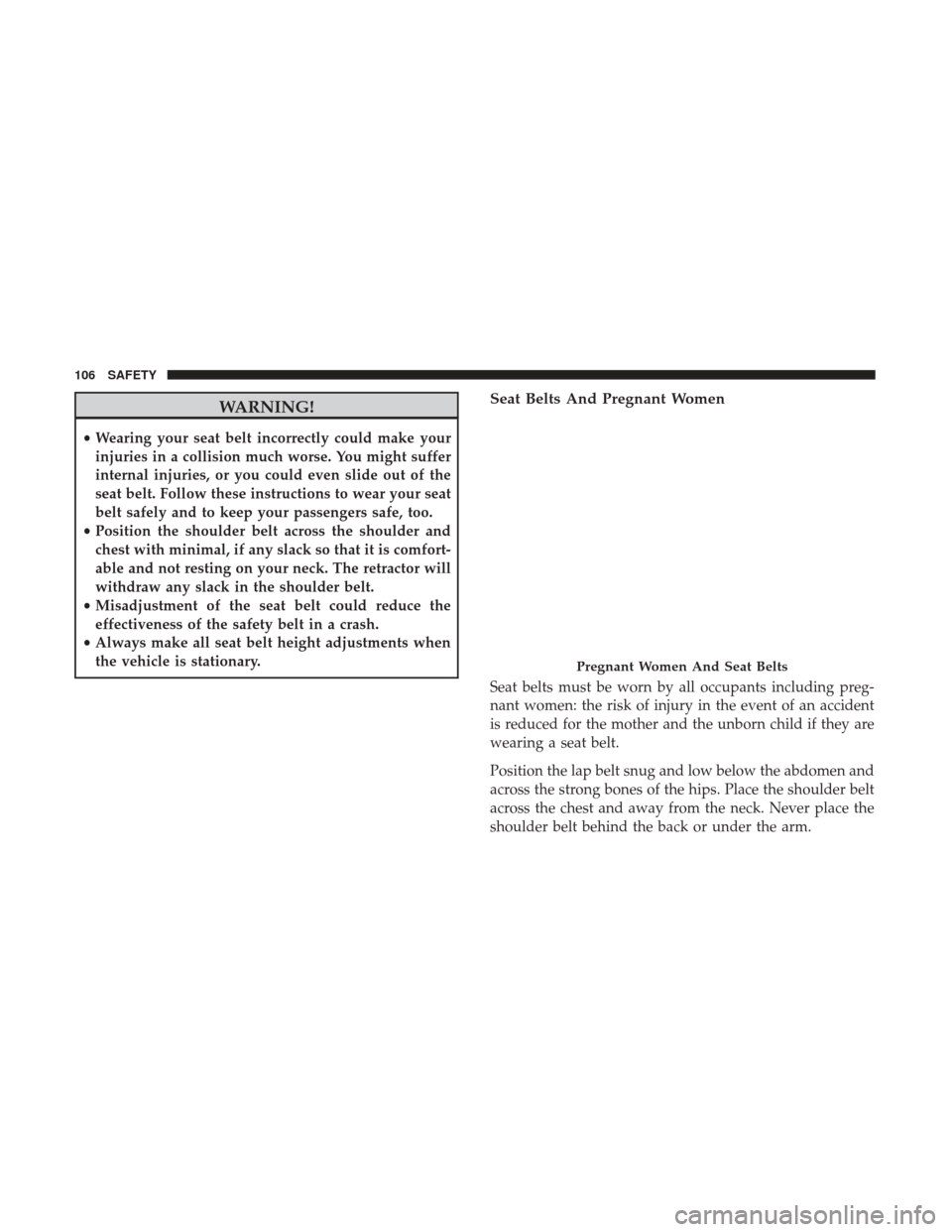Page 31 of 348

SEATS
Seats are a part of the Occupant Restraint System of the
vehicle.
WARNING!
•It is dangerous to ride in a cargo area, inside or
outside of a vehicle. In a collision, people riding in
these areas are more likely to be seriously injured or
killed.
• Do not allow people to ride in any area of your
vehicle that is not equipped with seats and seat belts.
In a collision, people riding in these areas are more
likely to be seriously injured or killed.
• Be sure everyone in your vehicle is in a seat and
using a seat belt properly.
Manual Adjustment (Front Seats)
The front driver and passenger seats can be adjusted
forward and rearward, and if equipped, may be reclined
and the height and lumbar can be adjusted.
WARNING!
• Adjusting a seat while driving may be dangerous.
Moving a seat while driving could result in loss of
control which could cause a collision and serious
injury or death.
• Seats should be adjusted before fastening the seat
belts and while the vehicle is parked. Serious injury
or death could result from a poorly adjusted seat belt.
3
GETTING TO KNOW YOUR VEHICLE 29
Page 32 of 348

Forward And Rearward Adjustment
The adjustment bar is at the front of the seat, near the floor.
Pull the bar upward to move the seat forward or rearward.
Release the bar once the seat is in the desired position.
Then, using body pressure, move forward and rearward on
the seat to be sure that the seat adjusters have latched.
Height Adjustment — If Equipped
The height adjustment lever is located on the center
outboard side of the seat. Lift up or push down on the front
lever to adjust the front of the seat up or down.
Recliner Adjustment
The recliner knob is on the rear outboard side of the seat. To
recline the seatback, rotate the knob rearward without
leaning back. To return the seatback to its normal upright
position, lean forward, rotate the knob forward until the
seatback is in the upright position.
Lumbar Support — If Equipped
This feature allows you to increase or decrease the amount
of lumbar support. The lumbar control knob is located on
the rear upper outboard side of the seatback. Rotate the
control forward to increase and rearward to decrease the
desired amount of lumbar support.
WARNING!
•Adjusting a seat while the vehicle is moving is
dangerous. The sudden movement of the seat could
cause you to lose control. The seat belt might not be
(Continued)
Seat Adjustments
1 — Forward/Rearward Adjustment Bar
2 — Height Adjustment Lever
3 — Recliner Knob
4 — Lumbar Knob 30 GETTING TO KNOW YOUR VEHICLE
Page 36 of 348

HEAD RESTRAINTS
Head restraints are designed to reduce the risk of injury by
restricting head movement in the event of a rear impact.
Head restraints should be adjusted so that the top of the
head restraint is located above the top of your ear.
WARNING!
•All occupants, including the driver, should not oper-
ate a vehicle or sit in a vehicle’s seat until the head
restraints are placed in their proper positions in
order to minimize the risk of neck injury in the event
of a crash.
• Head restraints should never be adjusted while the
vehicle is in motion. Driving a vehicle with the head
restraints improperly adjusted or removed could
cause serious injury or death in the event of a
collision.
Front Adjustment
To raise the head restraint, push the adjustment button,
located on the base of the head restraint, pull upward on
the head restraint. To lower the head restraint, push the
adjustment button, located on the base of the head re-
straint, and push downward on the head restraint.
Rear Adjustment
The center head restraint is adjustable and removable. To
raise the head restraint, push and hold the adjustment
button, located on the base of the head restraint and pull
upward on the head restraint. To lower the head restraint,
push and hold the adjustment button, and push downward
on the head restraint till the desired height is reached.
Front Head Restraint
1 — Release Button
2 — Adjustment Button
34 GETTING TO KNOW YOUR VEHICLE
Page 37 of 348

WARNING!
ALL the head restraints MUST be reinstalled in the
vehicle to properly protect the occupants. Follow the
re-installation instructions above prior to operating the
vehicle or occupying a seat.
WARNING!
A loose head restraint thrown forward in a collision or
hard stop could cause serious injury or death to occu-
pants of the vehicle. Always securely stow removed
head restraints in a location outside the occupant
compartment.
Front Removal
To remove the head restraint, raise it as far as it can go then
push the release button and the adjustment button at the
base of each post while pulling the head restraint up. To
reinstall the head restraint, put the head restraint posts into
the holes and push downward. Then adjust the head
restraint to the appropriate height.
WARNING!
•A loose head restraint thrown forward in a collision
or hard stop could cause serious injury or death to
occupants of the vehicle. Always securely stow re-
moved head restraints in a location outside the
occupant compartment.
(Continued)
Center Head Restraint
1 — Release Button
2 — Adjustment Button
3
GETTING TO KNOW YOUR VEHICLE 35
Page 38 of 348
WARNING!(Continued)
•ALL the head restraints MUST be reinstalled in the
vehicle to properly protect the occupants. Follow the
re-installation instructions above prior to operating
the vehicle or occupying a seat.
Rear Removal
Outboard Head Restraints
The outboard head restraints can be removed by pushing
the release buttons, located at the base of the head restraint
and pull upward on the whole assembly. To reinstall the
head restraint, put the head restraint posts into the holes
and push downward. Then adjust it to the appropriate
height. Center Head Restraint
To remove the head restraint, push the release button and
adjustment button while pulling upward on the whole
assembly and raise it as far as it can go. To reinstall the
headrest, put the headrest posts into the holes while
pushing the release button and adjustment button. Then
adjust it to the appropriate height.
Outboard Head Restraint Release Buttons
36 GETTING TO KNOW YOUR VEHICLE
Page 108 of 348

WARNING!
•Wearing your seat belt incorrectly could make your
injuries in a collision much worse. You might suffer
internal injuries, or you could even slide out of the
seat belt. Follow these instructions to wear your seat
belt safely and to keep your passengers safe, too.
• Position the shoulder belt across the shoulder and
chest with minimal, if any slack so that it is comfort-
able and not resting on your neck. The retractor will
withdraw any slack in the shoulder belt.
• Misadjustment of the seat belt could reduce the
effectiveness of the safety belt in a crash.
• Always make all seat belt height adjustments when
the vehicle is stationary.
Seat Belts And Pregnant Women
Seat belts must be worn by all occupants including preg-
nant women: the risk of injury in the event of an accident
is reduced for the mother and the unborn child if they are
wearing a seat belt.
Position the lap belt snug and low below the abdomen and
across the strong bones of the hips. Place the shoulder belt
across the chest and away from the neck. Never place the
shoulder belt behind the back or under the arm.
Pregnant Women And Seat Belts
106 SAFETY